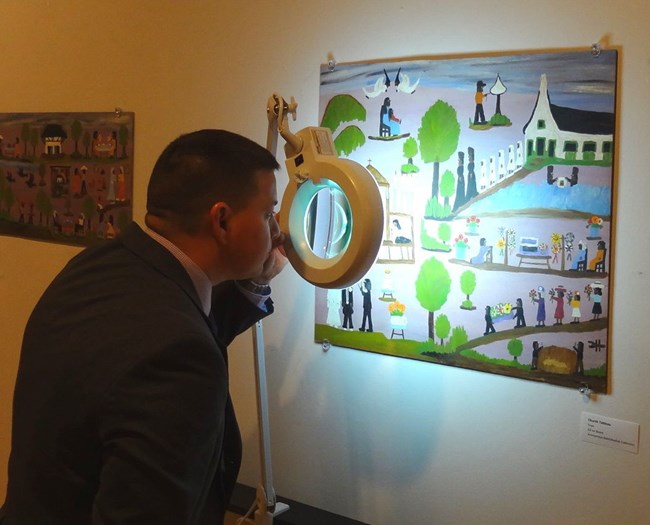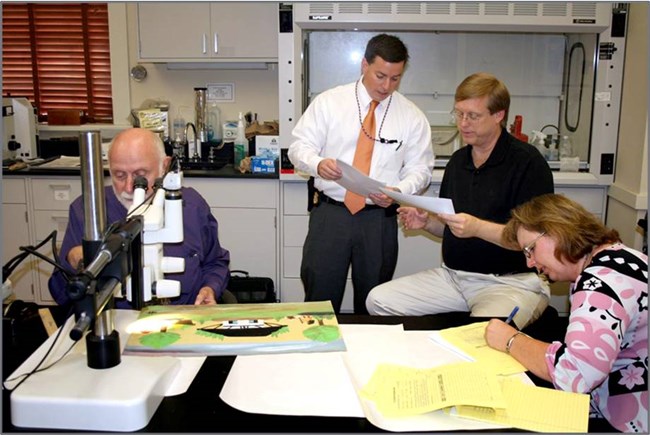Last updated: April 7, 2025
Article
Podcast 050: FBI and Art Crime: William Toye and Clementine Hunter

National Park Service
Forgeries of Clementine Hunter Art
Jason Church: This is Jason Church of the National Park Service’s National Center for Preservation Technology and Training, and today I’m here talking with Special Agent Randy Deaton of the FBI.
Jason Church: Now Randy, I know you were involved in a pretty major case recently with the Toyes being forgers of Clementine Hunter artwork. Can you tell us a little bit about that case and what your role was in it?
Randy Deaton: I was a lead investigator on this particular case. It involved three main subjects that were ultimately successfully prosecuted, convicted, and sentenced for selling and creating forged works that were Clementine Hunter, the folk artist, forgeries.
Randy Deaton: It was a case that involved a conspiracy amongst three people, a lot of victims, a large loss amount, spanned the country and it basically involved an art forger that had at least a forty year career forging art.
Jason Church: Then not only were they forging art, what else were they forging?
Randy Deaton: In addition to the actual works of art, part of the case was also a large amount of forged or fraudulent letters of provenance that was associated with other art work, other fine art forgeries and also with Clementine Hunter forgeries.
Jason Church: What made this particular case, what made this crime worth pursuing as an FBI agent?
Randy Deaton: Basically again, you had a conspiracy, multiple people involved; you had a lot of victims over a long period of time, at least since the early 1970’s. You had a forty plus year career forger that was creating and getting works out into the public that were forgeries and you had victims that did not receive justice for crimes that they were victims of since the early 1970’s and you had a historical significance to this case. Clementine Hunter, if not the most well-known artist to ever come out of Louisiana, she was a folk artist that would not be considered a fine artist, but you know, it was significant and had a significant historical aspect to it, and we helped preserve her legacy and Louisiana’s art culture.
Art Crime: Fraud with Victims
Jason Church: Now I’ve heard people say that art crime is victimless, that art crime is not a real crime, there’s no death involved, it’s just a rich people losing money sort of thing. As an investigator, what do you think about art crime? What were the stakes in this case?
Randy Deaton: I think by definition, in order for something to be a crime, you have to have a victim. Whether someone may not be a victim of a monetary loss, it could be an actual physical loss like murder, but in this particular case you had some very good people that believed they were buying original pieces of art that was created by the artist, Clementine Hunter.
Randy Deaton: They were told various stories to support the sales of these paintings, and we had victims that were some well-to-do, some not well-to-do normal people, all good people that don’t deserve to be victims of crime just like no one deserves to be a victim of a crime. I think some victims in this case were destitute after they learned they had forgeries but still they deserve justice just like anyone else.

National Park Service
40 Years of Art Forgery
Jason Church: As far as art crime goes, was this case any different? What made this case a little bit special?
Randy Deaton: This case was unique in a number of aspects to include, you had an art forger with at least a forty year career in forging art and this involved folk art, not what the public knows as fine art, Renoir, Matisse, Gauguin, you know this involved a Louisiana folk artist.
Randy Deaton: You had a large, large number of forgeries involved in this case and you had a number of private laboratories that the US government had consulted with and contracted with in order to do forensic work that the FBI lab just couldn’t do and all of it in support of a prosecution in this case.
Sentencing, Restitution & Age
Jason Church: Now the sentencing itself, how was that a little bit different?
Randy Deaton: In what aspect?
Jason Church: That the Toyes had …
Randy Deaton: All three defendants were ordered to pay restitution, a large amount of restitution, and all of this is public record also. What I thought was unique about the case is that the federal judge presiding over the case and the sentencing, ordered Mr. and Mrs. Toye to assist in the identification and cataloging of forgeries created by Mr. William Toye to include some victims wanted their forgeries to be signed by Mr. Toye, which did occur.
Jason Church: Of the ones that were catalogued, what’s the numbers on this case that you know of?
Randy Deaton: There’s no way anyone can say a specific exact number of Clementine Hunter forgeries created by Mr. Toye. That number is just not known, the exact number to be 100% certain, but there were over two hundred forgeries that were involved in this case that were ultimately identified.
Jason Church: Now if you’re a listener and you have a Clementine Hunter, maybe you bought it from Robbie Lucky, maybe you didn’t, if you think you have a forgery, what should you do? What’s the next step as an art collector who might have a forgery?
Randy Deaton: Well if you bought it from Mr. Toye or Mr. Lucky, then I would certainly be suspect of what I bought. Go to someone that or find out, an appraiser maybe or an authenticator. And just generally speaking of art in general, you want to consult with people and talk to people and have various people that have a lot of experience looking at certain pieces of art and get their opinion and ultimately whether you have a forgery or you have a real painting by a certain artist, it’s all a matter of taste for the owner.
Randy Deaton: You may like the forgery better than you do the original; it’s all in the person who owns the painting. But I would also say if you have any information about art forgery or someone committing these types of crimes, you can always call the FBI.
Jason Church: Just out of curiosity, I know the Toyes have been involved in forgeries of Matisse, Gaugin, Degas and things like that, do you have any idea what might have switched them to start doing an outsider artist , doing this self-taught artist from Louisiana. What might have switched them from the impressionists?
Randy Deaton: Yeah, I think at the time, from the investigation looking at everything, when Mr. Toye was arrested by the New Orleans Police Department in early 1970’s, at that time there was a big show of Clementine Hunter’s works that was going on at the time. There was a surge in popularity for her paintings. I don’t know for certain.
Randy Deaton: That could have caused that group of forgeries to come out then. In this particular case, late 1990’s, early 2000, this new group of Toye Clementine forgeries started coming out, maybe there was something going on at that time that would have meant a surge in popularity for Clementine Hunter that made it more valuable to some people, more collectible at the time. Who knows? Who knows?
Jason Church: So we know the Toyes were forging a variety. Now they’ve been prosecuted for the Clementine’s. We assume of course that’s the end of their forging career. Was there any movement to go back and look at past crimes? Is there any restitution on art crime? I mean any statute of limitation on art crime?
Randy Deaton: Well there’s no federal law like an art crime law. In this particular case, you had conspiracy charges and mail and wire fraud charges and there are statutes of limitations on those. So if you were a victim of wire fraud in 1970, the federal statute of limitations has run out years ago.
Randy Deaton: So somebody can’t be prosecuted for that per se. A lot of the fine art forgeries that were linked to Mr. Toye and Mrs. Toye, that’s conduct that was never prosecuted so at this point it’s just an allegation. They were never prosecuted for that. Thank God we live in a country where everybody’s innocent until proven guilty.
Jason Church: Anything else you want to add to this case?
Randy Deaton: It was a very challenging case, involved a lot of good people, a lot of victims in this case and really good people. It was a pleasure to meet with them under not so well circumstances but I think what made this case was the honesty, the professionalism, and the cooperation that the victims put forth, not the investigators, not the prosecutors, not the scientists, but the victims in this case that chose to cooperate with the US government.
Randy Deaton: They’re pretty much the heroes in the case. I can write reports all day and go interview people, but ultimately it would have been them that went to court had we gone to trial and told their story. So you’ve got a case driven by victims and there’s four victims, to give them justice even if it was from forty years ago.
Jason Church: Well Agent Deaton we really appreciate your coming and talking to us today. Hopefully we don’t have to talk to you in the future about more art crimes. But I think we know that you’re always available if we have any questions and if we run across anything ourselves that we can contact you.
Randy Deaton: And again, if the public has information about art crime occurring, call your local FBI office no matter where you are.
Jason Church: Alright. Thank you.
Read other Preservation Technology Podcast articles or learn more about the National Center for Preservation Technology and Training.
